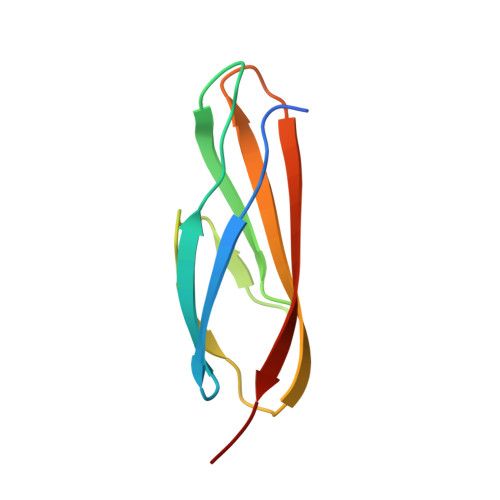Calcium binding by the PKD1 domain regulates interdomain flexibility in Vibrio cholerae metalloprotease PrtV.
Edwin, A., Rompikuntal, P., Bjorn, E., Stier, G., Wai, S.N., Sauer-Eriksson, A.E.(2013) FEBS Open Bio 3: 263-270
- PubMed: 23905008
- DOI: https://doi.org/10.1016/j.fob.2013.06.003
- Primary Citation of Related Structures:
4L9D - PubMed Abstract:
Vibrio cholerae, the causative agent of cholera, releases several virulence factors including secreted proteases when it infects its host. These factors attack host cell proteins and break down tissue barriers and cellular matrix components such as collagen, laminin, fibronectin, keratin, elastin, and they induce necrotic tissue damage. The secreted protease PrtV constitutes one virulence factors of V. cholerae. It is a metalloprotease belonging to the M6 peptidase family. The protein is expressed as an inactive, multidomain, 102 kDa pre-pro-protein that undergoes several N- and C-terminal modifications after which it is secreted as an intermediate variant of 81 kDa. After secretion from the bacteria, additional proteolytic steps occur to produce the 55 kDa active M6 metalloprotease. The domain arrangement of PrtV is likely to play an important role in these maturation steps, which are known to be regulated by calcium. However, the molecular mechanism by which calcium controls proteolysis is unknown. In this study, we report the atomic resolution crystal structure of the PKD1 domain from V. cholera PrtV (residues 755-838) determined at 1.1 Å. The structure reveals a previously uncharacterized Ca(2+)-binding site located near linker regions between domains. Conformational changes in the Ca(2+)-free and Ca(2+)-bound forms suggest that Ca(2+)-binding at the PKD1 domain controls domain linker flexibility, and plays an important structural role, providing stability to the PrtV protein.
Organizational Affiliation:
Department of Chemistry, Umeå University, Umeå SE-901 87, Sweden ; Umeå Centre for Microbial Research (UCMR), Umeå University, Umeå SE-901 87, Sweden.


















